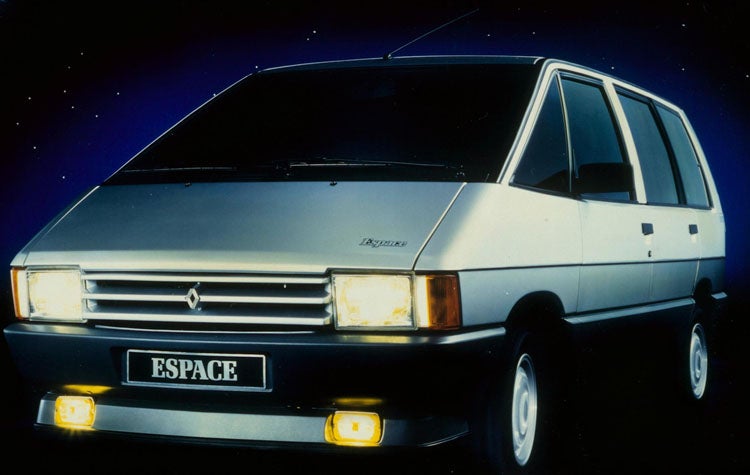The Renault Espace
It created a new market. But, says Giles Chapman, the credit may belong elsewhere

Renault invents the MPV. Launches Espace. Makes a million of them and rules the market. The end. Or so its smooth-talking Paris PR people would have us believe.
Renault invents the MPV. Launches Espace. Makes a million of them and rules the market. The end. Or so its smooth-talking Paris PR people would have us believe.
The Espace went on sale 20 years ago this month, and Renault is justifiably proud its seven-seater people-carrier, probably still the most fashionable on offer, accounts for more than one in five European MPV sales.
Renault, however, certainly didn't pioneer the MPV concept. And, by rights, the Espace should have worn the badge of its arch-enemy Peugeot. And, even more surprisingly, early plans for the Espace were sketched not in some sun-dappled Paris design salon, but in the downbeat environment of Britain's West Midlands.
The Dodge Ram delivery van of the early 1970s was actually the catalyst for the Espace. In the US, it was a big seller but Chrysler Corporation truck executives noticed that versions with windows and extra seats began to catch on with large American families.
The Dodge truck division's market research findings were passed to Chrysler's car development team and, in 1978, 100 designers began work on Project T-115 - literally, a 'mini van'. Five years later, it was launched as the Plymouth Voyager and Dodge Caravan.
By coincidence, a 28-year old Royal College of Art car design graduate called Fergus Pollock was working at Chrysler's Detroit nerve- centre, on secondment from Britain, and Project T-115 made a big impression on him. Upon his return to Chrysler UK's Coventry design studios, he set about creating his own seven-seater.
Meanwhile, Chrysler's European subsidiary was sold to Peugeot. The new owner discovered Pollock's prototype, codenamed P16, was being crafted in partnership with French specialist company Matra. Pollock left to work for Citroen and so Matra's Antoine Volanis refined the P16's shape.
And it's at this point, in late 1979, that either some eerie parallel thinking took place, or else industrial espionage, because Renault claims to have come up with its own scheme for "a grand touring saloon inspired by the passenger van".
Peugeot, concerned the P16 was just too radical for buyers accustomed to its traditional estate cars, eventually abandoned it. It was a corporate mistake of epic proportions, because Matra teamed up with Renault and on 15 December 1982 they began work together on P23, the car that became the Espace and, by extension, the definitive European MPV.
Renault reckoned the Espace would be a niche product. That's why it contracted-out manufacture to Matra and decided to build the bodywork from glassfibre. This also gave the car a low weight, endowing it with a nimbleness that belied its towering stance.
Once you got used to the raked windscreen that appeared to be several yards away from the steering wheel, you found the 2-litre petrol or turbodiesel engines made the Espace pretty pokey. Cornering, thanks to front-wheel drive, was also excellent.
Just as with the original Mini, initial Espace sales were sporadic. But, in 1985, orders started to rocket, with production beginning at a second plant in 1987 to meet them. Buyers eagerly specified options like twin sunroofs, air conditioning and four-wheel drive.
By the time the second-generation Espace was launched in 1991, 182,000 cars had been sold, and the veratile, stylish Espace had, from nowhere, elbowed its way in between the Range Rovers and Volvo estates on school runs across Britain.
The third incarnation, unveiled in October 1996 brought the further novelty of a 23in-longer Grand Espace version, with cavernous extra luggage space behind the third row of seating. The fourth, arriving in 2002, boasts avant-garde styling and a world-record Euro NCAP crash rating.
Renault now loftily pitches its Espace against executive cars like Mercedes-Benzes rather than the massed ranks of MPV imitators the car has inspired in the two decades since its debut. Prestige is now on a par with practicality. Yet one of the Espace's unique elements, its plastic shell, has been discarded. The latest model has an all-metal structure, with the option of V6 petrol and diesel engines to haul this altogether heavier beast along.
The millionth Espace has recently been built, but pity the team at poor old Matra: despite being the linchpin of the whole Espace phenomenon, Renault now assembles the Espace in-house and Matra Automobile has all but closed down. Truly, the one victim of the Espace's phenomenal success.
Join our commenting forum
Join thought-provoking conversations, follow other Independent readers and see their replies
Comments
Bookmark popover
Removed from bookmarks